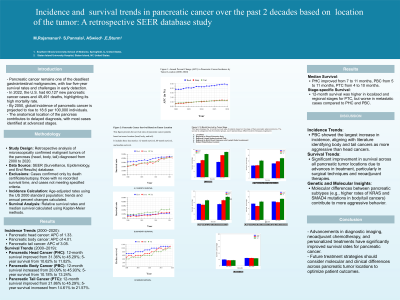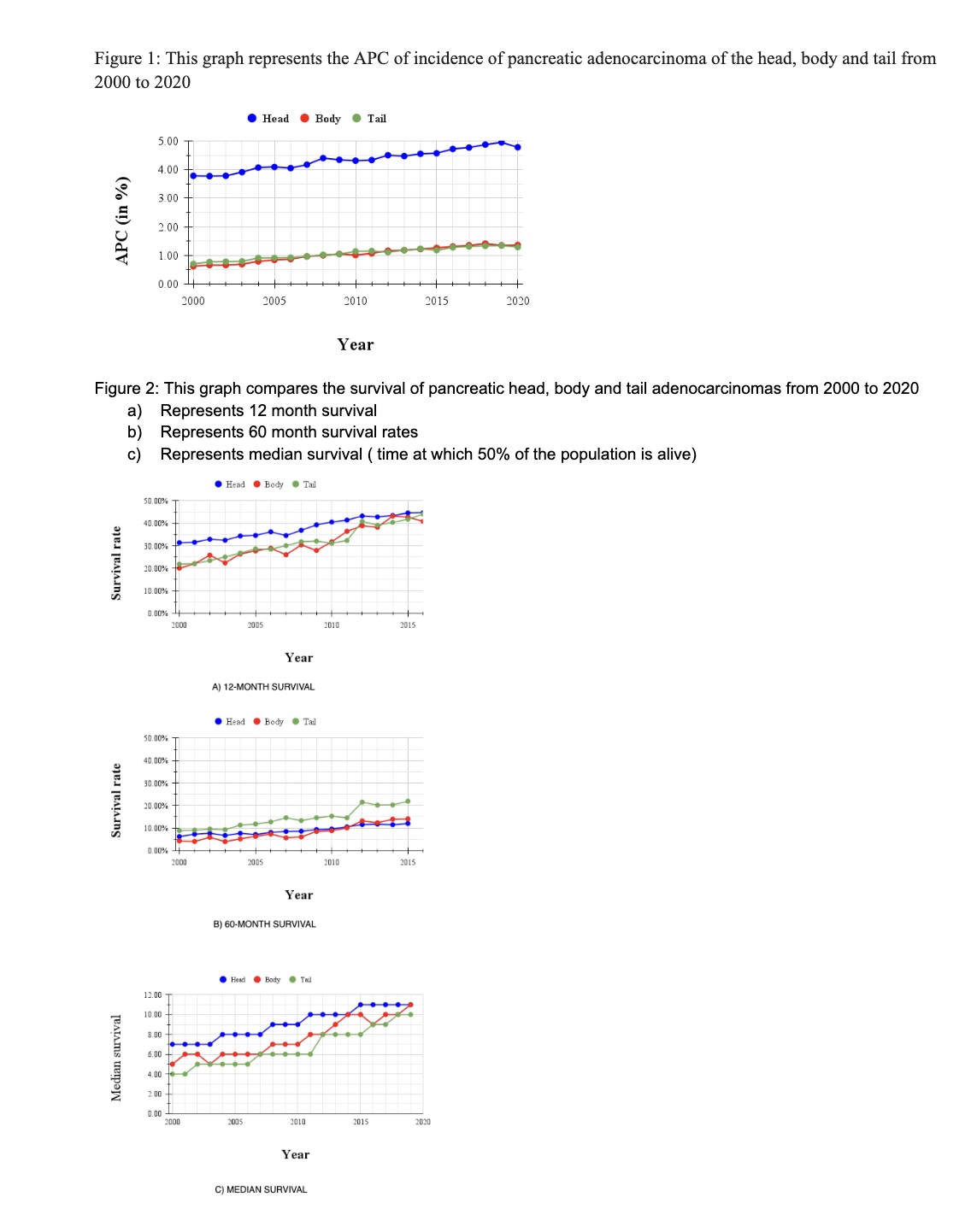Monday Poster Session
Category: Biliary/Pancreas
P1719 - Incidence and Survival Trends in Pancreatic Cancer Over the Past 2 Decades Based on the Location of the Tumor: A Retrospective Study
Monday, October 28, 2024
10:30 AM - 4:00 PM ET
Location: Exhibit Hall E

Has Audio

Medha Rajamanuri, MBBS
Southern Illinois University
springfield, IL
Presenting Author(s)
Medha Rajamanuri, MBBS1, Sai Shanmukha Sreeram Pannala, MD2, Rahul Sundar, 3, Emily Sturm, MD1, Abdul Swied, MD4
1Southern Illinois University, Springfield, IL; 2Staten Island University Hospital, Northwell Health, Staten Island, NY; 3Indian Institute of Technology Madras, Hyderabad, Telangana, India; 4Southern Illinois University School of Medicine, Springfield, IL
Introduction: Pancreatic cancer manifests distinctly in the pancreatic head (PHC) and body/tail (PBTC) regions due to their differing embryological origins, resulting in variations in cellular composition, vascularization, lymphatic drainage, and innervation. No study to date has compared the incidence and survival of pancreatic tumors in different anatomical locations over the past two decades. This study aims to fill this gap by examining trends in incidence and survival rates of pancreatic cancers and assessing the impact of modern therapies.
Methods: This retrospective study focuses on microscopically confirmed, malignant primary tumors of the head, body, and tail of the pancreas. Data were collected from the Incidence-SEER research database, for tumor cases diagnosed from 2000 to 2020. Incidence rates were age-adjusted to the US 2000 standard population, with trends and annual percent changes (APC) calculated. Survival analysis involved relative survival rates and median survival using Kaplan-Meier methods.
Results: From 2000 to 2020, a total of 110,872 cases of PHC, 28,205 body of pancreas tumors, and 32,960 tail of the pancreas tumors were included. The PHC had the highest incidence compared to the body and tail, which were nearly the same. However, cumulative APC (2000-2020) was highest for the body of the pancreas at 4.01 (p< 0.05), followed by the tail at 3.05 (p< 0.05), and the head at 1.33 (p< 0.05). In terms of survival, the 12-month survival rates improved significantly: PHC from 31.36% to 46.93%, body from 20.9% to 45.3%, and tail from 21.86% to 45.29%. The 60-month survival rates also improved: PHC from 6.32% to 12.09%, body from 4.4% to 14.12%, and tail from 8.93% to 21.97%. Median survival improved for PHC from 7 to 11 months, body from 5 to 11 months, and tail from 4 to 10 months.
Discussion: The incidence of pancreatic adenocarcinoma is highest in the head of the pancreas, though it has been steadily rising in all regions. The APC is greater for the body and tail, likely due to increased imaging and earlier detection. Overall survival has improved, particularly for the body and tail, with median survival now comparable to that of the head. This improvement is attributed to improved medical therapies and surgical techniques. The positive trend in survival for pancreatic body and tail tumors is encouraging, warranting further research into potential causes of this survival advantage and the benefits of targeted medical regimens for different anatomical sites of pancreatic tumors.

Disclosures:
Medha Rajamanuri, MBBS1, Sai Shanmukha Sreeram Pannala, MD2, Rahul Sundar, 3, Emily Sturm, MD1, Abdul Swied, MD4. P1719 - Incidence and Survival Trends in Pancreatic Cancer Over the Past 2 Decades Based on the Location of the Tumor: A Retrospective Study, ACG 2024 Annual Scientific Meeting Abstracts. Philadelphia, PA: American College of Gastroenterology.
1Southern Illinois University, Springfield, IL; 2Staten Island University Hospital, Northwell Health, Staten Island, NY; 3Indian Institute of Technology Madras, Hyderabad, Telangana, India; 4Southern Illinois University School of Medicine, Springfield, IL
Introduction: Pancreatic cancer manifests distinctly in the pancreatic head (PHC) and body/tail (PBTC) regions due to their differing embryological origins, resulting in variations in cellular composition, vascularization, lymphatic drainage, and innervation. No study to date has compared the incidence and survival of pancreatic tumors in different anatomical locations over the past two decades. This study aims to fill this gap by examining trends in incidence and survival rates of pancreatic cancers and assessing the impact of modern therapies.
Methods: This retrospective study focuses on microscopically confirmed, malignant primary tumors of the head, body, and tail of the pancreas. Data were collected from the Incidence-SEER research database, for tumor cases diagnosed from 2000 to 2020. Incidence rates were age-adjusted to the US 2000 standard population, with trends and annual percent changes (APC) calculated. Survival analysis involved relative survival rates and median survival using Kaplan-Meier methods.
Results: From 2000 to 2020, a total of 110,872 cases of PHC, 28,205 body of pancreas tumors, and 32,960 tail of the pancreas tumors were included. The PHC had the highest incidence compared to the body and tail, which were nearly the same. However, cumulative APC (2000-2020) was highest for the body of the pancreas at 4.01 (p< 0.05), followed by the tail at 3.05 (p< 0.05), and the head at 1.33 (p< 0.05). In terms of survival, the 12-month survival rates improved significantly: PHC from 31.36% to 46.93%, body from 20.9% to 45.3%, and tail from 21.86% to 45.29%. The 60-month survival rates also improved: PHC from 6.32% to 12.09%, body from 4.4% to 14.12%, and tail from 8.93% to 21.97%. Median survival improved for PHC from 7 to 11 months, body from 5 to 11 months, and tail from 4 to 10 months.
Discussion: The incidence of pancreatic adenocarcinoma is highest in the head of the pancreas, though it has been steadily rising in all regions. The APC is greater for the body and tail, likely due to increased imaging and earlier detection. Overall survival has improved, particularly for the body and tail, with median survival now comparable to that of the head. This improvement is attributed to improved medical therapies and surgical techniques. The positive trend in survival for pancreatic body and tail tumors is encouraging, warranting further research into potential causes of this survival advantage and the benefits of targeted medical regimens for different anatomical sites of pancreatic tumors.

Figure: Incidence trends in Pancreatic head, body and tail from 2000-2020
Survival (12 month, 60 month, median survival) trends in Pancreatic Head, body and tail.
Survival (12 month, 60 month, median survival) trends in Pancreatic Head, body and tail.
Disclosures:
Medha Rajamanuri indicated no relevant financial relationships.
Sai Shanmukha Sreeram Pannala indicated no relevant financial relationships.
Rahul Sundar indicated no relevant financial relationships.
Emily Sturm indicated no relevant financial relationships.
Abdul Swied indicated no relevant financial relationships.
Medha Rajamanuri, MBBS1, Sai Shanmukha Sreeram Pannala, MD2, Rahul Sundar, 3, Emily Sturm, MD1, Abdul Swied, MD4. P1719 - Incidence and Survival Trends in Pancreatic Cancer Over the Past 2 Decades Based on the Location of the Tumor: A Retrospective Study, ACG 2024 Annual Scientific Meeting Abstracts. Philadelphia, PA: American College of Gastroenterology.
